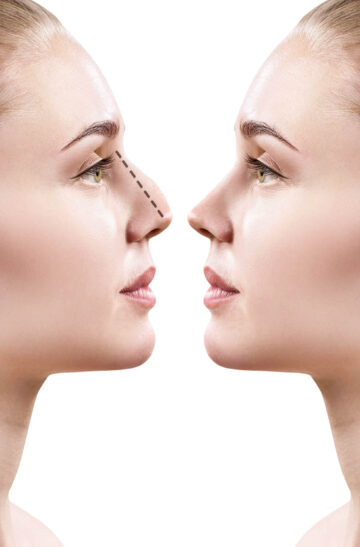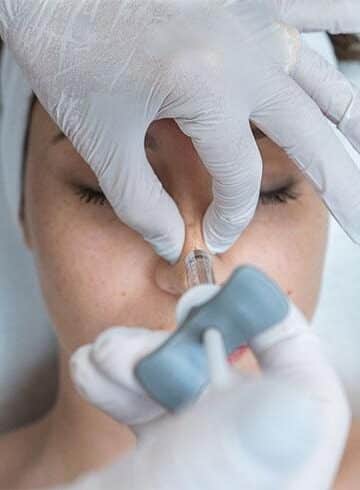Nose surgery in Geneva
The aim of Rhinoplasty is to modify the shape of the nasal pyramid (partially or totally) and to correct a possible respiratory problem. A rhinoplasty can be combined, if necessary, with other complementary facial procedures, in particular a genioplasty (reshaping of the chin).
The result for our customers
Book a FREE 3D consultation and we will show you results from our clients that are close to your personal case
To book your consultation or find out detailed prices, please fill out the form
About rhinoplasty
Thanks to our cutting-edge technology with the latest medical lasers, as well as our unrivaled hair removal expertise, you can say goodbye to unwanted hair for good, whatever your skin or hair type.
Aesthetic surgery
Incisions: classically, they are hidden inside the nostrils, resulting in a non-visible scar. However, some external incisions may be necessary if the tip needs to be resurfaced, nevertheless the scars are almost imperceptible. Correction of the bone-cartilage structure is carried out according to local abnormalities and is possible after release of the skin. Nose width, bumps and deviations can also be corrected. Grafts can be used to achieve an excellent result. Dressings and splints. The nose is normally draped with a modeling cast to protect it, made of plaster, plastic or metal, and small adhesive strips. The nostrils are sometimes blocked with special absorbable dressings. The procedure lasts approximately one to two hours. The immediate postoperative period is not painful, but having a stuffy nose (bandages) for two or three days can be uncomfortable. Edema (swelling) and sometimes bruising may be observed around the eyes and their duration varies from one individual to another. It is recommended to rest and not do intense exercise for a few days after the intervention. The nasal plugs are removed between the 2nd and 5th postoperative day. The splint is removed between the 5th and 8th day, then it will sometimes be replaced with a new, smaller splint for a few days. The marks produced by the intervention will gradually fade, allowing a return to normal socio-professional life after a few days (10 to 20 days depending on the severity of the consequences). Sport should be avoided for the first three months.
First consultation
with 3D simulation
in Geneva, Gstaad and Montreux
Complete the form to request the free consultation
Go to FormFirst consultation
with 3D simulation
in Geneva, Gstaad and Montreux
First CONSULTATION
with 3D simulation
in Geneva, Gstaad and Montreux!
Complete the form to request the free consultation
Go to FormType of Rhinoplasty & Treatment Methods.

Surgical rhinoplasty

Medical (non-surgical) rhinoplasty
Bandage
A routine preoperative evaluation is performed in accordance with federal regulations. The anesthesiologist examines the patient at least 48 hours before the procedure. Any medication containing aspirin should be stopped 10 days before the procedure.
Working time
The nasal plugs are removed between the 2nd and 5th postoperative day. The splint is removed between the 5th and 8th day.
The results
Two to three months are necessary to have a good outline of the result, knowing that the final appearance will only be obtained after six months to a year. This result is, in general, consistent with the patient’s wishes and quite close to the project established during the preoperative plan. The operation provides a generally quite appreciable morphological and aesthetic improvement, as well as a considerable psychological benefit.
Type of anesthesia and hospitalization
This surgery is usually performed under general anesthesia. However, in some cases, deep local anesthesia with sedatives is possible. The choice between these different techniques will be discussed between you, the surgeon and the anesthesiologist. No hospitalization is necessarily required.
However, depending on certain constraints, a short hospitalization may be preferable. It is nevertheless necessary to be aware of the possible complications: bleeding, possible in the first hours but which most often remains very moderate. When they are too important this may justify conditioning (new dressings in the nostrils). Hematomas may require evacuation if they are large or too painful. Infections are very rare despite the natural presence of microbes in the nasal passages.
If necessary, they warrant appropriate treatment. Anesthetic scars, linked only to external scars (when they exist) and almost never require surgical reintervention. Skin bruising, although rare, is possible, often a consequence of the nasal splint.
Simple wounds or erosions heal spontaneously without leaving any traces, unlike skin necrosis, which fortunately only leaves a small scar. They may result from a misunderstanding of the objectives or occur because of unusual scarring phenomena or unexpected tissue reactions such as poor spontaneous rehabilitation of the skin or retractile fibrosis.
These small imperfections, if they are intolerable, can be corrected by a final surgical improvement, generally much simpler than the initial surgery, both from the technical point of view and from the post-operative point of view. However, such a final improvement cannot be achieved before several months after the first intervention, given the need to work on stabilized tissues that have reached good scar maturation.
Minimal corrections, if necessary, must be carried out at least one year after the procedure. Fortunately, real complications following rhinoplasty are rare. In practice, the vast majority of operations progress without problems and patients are fully satisfied with the result. However, you must be aware of the possible complications: bleeding, possible in the first hours but most often remains very moderate. When they are too important this may justify conditioning (new dressings in the nostrils).
Hematomas may require evacuation if they are large or too painful. Infections are very rare despite the natural presence of microbes in the nasal passages. If necessary, they warrant appropriate treatment.
Anesthetic scars, linked only to external scars (when they exist) and almost never require surgical reintervention. Skin bruising, although rare, is possible, often a consequence of the nasal splint. Simple wounds or erosions heal spontaneously without leaving any traces, unlike skin necrosis, which fortunately only leaves a small scar.


































































































































